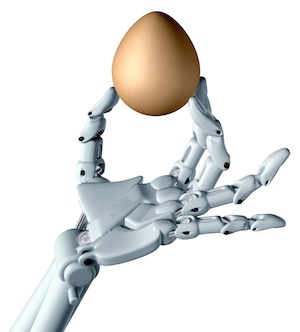 In the more than 50 years spanning between 1948 and 2011, the annual production of U.S. farms increased by an average of 1.49 percent every year according to data collected and analyzed by the U.S. Department of Agriculture (USDA). In the two decades between 1991 and 2011, cow milk and corn production levels rose by about one-third and table grape production rose by 28 percent. Productivity gains in agriculture stem from a variety of factors, such as technological advances in machinery or chemical inputs as well as labor productivity levels.
In the more than 50 years spanning between 1948 and 2011, the annual production of U.S. farms increased by an average of 1.49 percent every year according to data collected and analyzed by the U.S. Department of Agriculture (USDA). In the two decades between 1991 and 2011, cow milk and corn production levels rose by about one-third and table grape production rose by 28 percent. Productivity gains in agriculture stem from a variety of factors, such as technological advances in machinery or chemical inputs as well as labor productivity levels.
Although U.S. farm production is fairly healthy, there are concerns for making sure that production levels continue to increase at a fast enough rate to account for expected global population growth in the coming decades. A July 2015 report published by the USDA’s Economic Research Service noted that restricted investment from the federal government in agricultural research could limit total factor productivity on American farms over the coming decades. This is compounded by a recent United Nations’ Food and Agriculture Organization forecast that global demand for food could increase 70 percent by 2050. If American farms could increase productivity to meet that demand, it would be an economic boon.
More and more, the agricultural world is looking towards the mechanization of labor processes through robotics as a way of potentially increasing their productivity. Robotics was identified as a sector of investment growth in agricultural tech by an April 2014 white paper on agriculture technologies published by the entrepreneurship and education non-profit Kauffman Foundation. Robotics is a regular focus of ours here on IPWatchdog, most recently visited in our coverage of the incredible advancements in walking and jumping robotics pioneered by Boston Dynamics, a Google Inc. (NASDAQ:GOOG) subsidiary. With American farmers already heavily involved in the regulatory conversation involving the commercial use of unmanned aerial vehicles (UAVs), or drones, we thought that it would be interesting to delve into the world of farming robotics and see the recent advances in that particular field.
It’s important to understand first that the robotics being developed for commercial use on farms won’t be stand-alone humanoid units ranging through fields to pick crops. Any piece of hardware implementing an algorithm which automates some of the manual work of farming falls under this heading. One good example of this is the LettuceBot, a precision thinning technology which works to visually characterize plants in a lettuce row, identify which plants to keep and eliminating unwanted plants to optimize yield. The unit doesn’t move by itself but is guided along by a tractor instead. The technology has been developed by Blue River Technology of Sunnyvale, CA, a company which has attracted $13 million in investment between 2011 and 2014 to commercialize this product. The LettuceBot’s creators hope to provide the technology as a third-party service to farm owners before manufacturing the unit for commercial sale.
[JV-1]
It’s a little easier to see the work of individual laborers being replaced by the HV-100 mobile robots being marketed by Harvest Automation of North Billerica, MA. These robotic units are designed to handle a wide array of plant handling tasks in greenhouses or outdoor environments, tasks such as plant collection, spacing and consolidation. A YouTube video uploaded by Harvest Automation displays four of these robotics units in use transporting potted plants on an outdoor lot. The company sells the HV-100 for use in greenhouse, hoophouse or nursery environments and the unit requires no programming on the part of a farmer. As of this April, the HV-100 was already catering to 30 customers with the company expecting to make more of a push into produce and not just nursery settings. A similar robotics product developed by Harvest Automation, the OmniVeyor TM-100, provides automated warehouse product collection and movement for e-commerce applications.
Berry picking is another farm task where labor can be used more productively thanks to the SW 6010, a robotic strawberry harvester developed by Spanish agricultural tech firm Agrobot. As this YouTube video uploaded by AgroBot shows, the SW 6010 picks strawberries from the bush when fully grown and sends the picked berries along on a conveyor belt towards a single operator who packages the fruit which is ready for sale. The strawberry harvester utilizes an artificial vision system known as AGvision which uses imaging sensors and data analysis to pick the ripest berries based on color and size. The harvesting unit itself has 24 robotic arms, each with two 24-volt DC motors. The artificial vision system scans strawberry beds at rates of 20 images per second to find the berries which are ready to be picked.
Human workers aren’t the only labor being obviated by recent developments in robotics. Colony collapse disorder (CCD) on bees has threatened a great source of crop pollination for a variety of commercial produce such as almonds, berries and a variety of fruits and vegetables. Teams of researchers working at Harvard University have developed agile robotic insects known as RoboBees, tiny electronic devices including airfoils, sensors, processing equipment and pollination appendages to autonomously pollinate a region of crops. These robotic units are being designed so that a fleet of these would be able to handle a task in a way that mimics the collective behavior and natural intelligence of a bee colony. The RoboBee, which has two wings that flap 120 times per second to keep the unit aloft, took its first successful flight during the summer of 2012. The technology, also often referred to as micro air vehicles, also has applications in search & rescue, hazardous environment exploration and even military surveillance.
Surveillance of large farm properties to quickly observe how crops are faring out in the field is enabled by the Hornet, an agricultural drone system sold by Agribotix of Boulder, CO. The Hornet performs field scouting of an area according to a predetermined mission plan, completing the entire task in autopilot mode. The Hornet can be operated with a separate Agribotix field reporting service known as FarmLens, which can produce field health and variable application reports from data collected by the Hornet or other drones. Although it’s developed by an American company, use of the Hornet has been stymied thus far in this country because of Federal Aviation Administration rules preventing beyond line-of-sight operations. Agribotix has flown successful drone missions for farming and related surveillance applications all over the world, from New Zealand to Sumatra to Mongolia.
Some countries are jumping more fully into the agricultural robotics fray than others. While American public funding for agricultural research stagnates, government officials in England have committed £160 million ($245.5 million USD) towards commercializing agricultural technologies and establishing centers of agricultural innovation which will seek to develop agricultural technologies for export. Here in America, however, the private sector is getting pretty heavily involved with agricultural tech in recent months. Google Ventures, the venture capital arm of the Internet technology behemoth, led a $15 million round of funding this May for Farmers Business Network Inc., a computerized farming network that provides data analytics that can help farmers optimize their crop yields. In late July another farming software startup, Granular, raised $18.7 million in a round of venture capital funding featuring a variety of investors including, again, Google Ventures.
There have been those who have bemoaned the effects of technological innovation on the agricultural industry in the past; a 2013 article published in the MIT Technology Review notes that agriculture supported 41 percent of the American workforce in 1900 but only 2 percent as of 2000. The coming wave of farming robotics will likely thin those numbers even more; the LettuceBot can perform the work of 20 farm laborers, for example. Of course, such fears of massive labor displacement are hard to realize in an industry where a shortage of workers has led to losses in productivity on many farms. Some have pointed out that increased productivity from robotic technologies doesn’t automatically lead to fewer available jobs and there is a truth to the fact that as more robotics are manufactured to perform farm work, more workers will be needed to manufacture those higher value robotic goods.

![[IPWatchdog Logo]](https://ipwatchdog.com/wp-content/themes/IPWatchdog%20-%202023/assets/images/temp/logo-small@2x.png)


![[Advertisement]](https://ipwatchdog.com/wp-content/uploads/2024/04/Patent-Litigation-Masters-2024-sidebar-early-bird-ends-Apr-21-last-chance-700x500-1.jpg)

![[Advertisement]](https://ipwatchdog.com/wp-content/uploads/2021/12/WEBINAR-336-x-280-px.png)
![[Advertisement]](https://ipwatchdog.com/wp-content/uploads/2021/12/2021-Patent-Practice-on-Demand-recorded-Feb-2021-336-x-280.jpg)
![[Advertisement]](https://ipwatchdog.com/wp-content/uploads/2021/12/Ad-4-The-Invent-Patent-System™.png)







Join the Discussion
One comment so far.
SC
October 1, 2015 04:04 pmI like the AgDrone System because it covers over a section in one flight with 2 sensors on board.